

Python and csound. Cabbage. The COSMO Project. /chapter: Preface / CSOUND. Csound is one of the best known and longest established programs in the field of audio programming.

It was developed in the mid-1980s at the Massachusetts Institute of Technology (MIT) by Barry Vercoe but Csound's history lies even deeper within the roots of computer music: it is a direct descendant of the oldest computer program for sound synthesis, 'MusicN', by Max Mathews. Csound is free and open source, distributed under the LGPL licence, and it is maintained and expanded by a core of developers with support from a wider global community. Package Search Results. You have searched for packages that names contain csound in all suites, all sections, and all architectures.
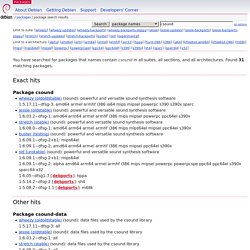
Found 31 matching packages. Exact hits. Csound/VST4CS_LINUX.md at develop · csound/csound. Csound. It is free software, available under the LGPL.
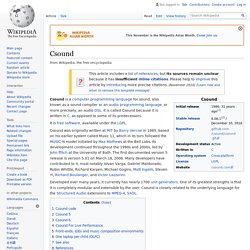
Csound was originally written at MIT by Barry Vercoe in 1985, based on his earlier system called Music 11, which in its turn followed the MUSIC-N model initiated by Max Mathews at the Bell Labs. Its development continued throughout the 1990s and 2000s, led by John ffitch at the University of Bath. The first documented version 5 release is version 5.01 on March 18, 2006.
Many developers have contributed to it, most notably Istvan Varga, Gabriel Maldonado, Robin Whittle, Richard Karpen, Michael Gogins, Matt Ingalls, Steven Yi, Richard Boulanger, and Victor Lazzarini. Developed over many years, it currently has nearly 1700 unit generators. Cshelp. Some Csound Helpers Abram's Csound Software Graphic table editing, FFT drawing, and a sequencer from Abram Hindle.
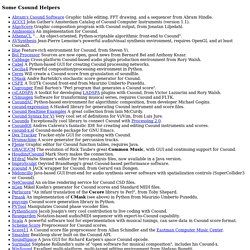
Raspberry Pi and realtime, low-latency audio [Linux-Sound] The Raspberry Pi can be set up to handle realtime, low-latency audio but it requires quite some tweaking.
![Raspberry Pi and realtime, low-latency audio [Linux-Sound]](http://cdn.pearltrees.com/s/pic/th/raspberry-realtime-latency-165410432)
Hence this Wiki article in which some common bottlenecks as well as some possible optimizations will be described. Last but not least this article will explain how to get JACK aka jackd running on your RPi. Powering the RPi If you use the micro-USB power input to power the RPi you might encounter sudden reboots when plugging in or unplugging USB devices. If you want to be sure your RPi doesn't reboot in such cases you can try backfeed powering your RPi by connecting the power supply to one of the USB ports or use a powered USB hub that backfeeds.
Overclocking With the raspi-config tool or by editing /boot/config.txt directly it is possible to overclock various parts of the RPi (CPU, GPU, SDRAM). More info on overclocking: CPU frequency scaling From the aforementioned link: “The latest kernel has a cpufreq kernel driver with the “ondemand” governor enabled by default. Distortion. Hans Mikelson hans@csounds.com tanh.orc tanh1.sco tanh2.sco Introduction This article discusses using the hyperbolic tangent function to simulate guitar tube or valve amplifier distortion.
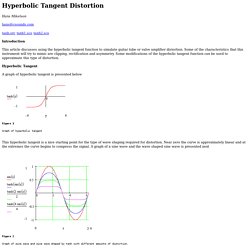
Some of the characteristics that this instrument will try to mimic are clipping, rectification and asymmetry. Hyperbolic Tangent A graph of hyperbolic tangent is presented below Figure 1 Graph of hyperbolic tangent. LISTSERV 16.0 - CSOUND List at LISTSERV.HEANET.IE. Belangeo/cecilia4csound: Ear-bending sonics. Csound-expression: library to make electronic music. Welcome to the simplest textual synthesizer. dac $ osc 440 Csound-expression is a Haskell framework for computer music.
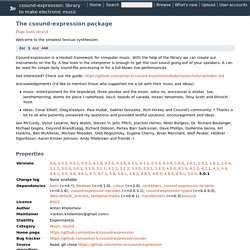
With the help of the library we can create our instruments on the fly. A few lines in the interpreter is enough to get the cool sound going out of your speakers. It can be used for simple daily sound-file processing or for a full-blown live performances. Got interested? Acknowledgements (I'd like to mention those who supported me a lot with their music and ideas): music: entertainment for the braindead, three pandas and the moon, odno no, annsannat & alizbar, toe, iamthemorning, atoms for piece / radiohead, loscil, boards of canada, Hozan Yamamoto, Tony Scott and Shinichi Yuize.
Devhub. LISTSERV 16.0 - CSOUND List at LISTSERV.HEANET.IE. Cabbage Audio. QuteCsound.
The Public Csound Manual Version 4.10. The Canonical Csound Reference Manual. Version 6.05 Barry Vercoe MIT Media Lab.
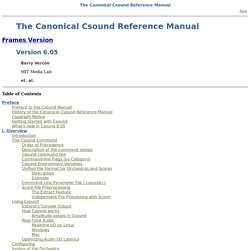
/chapter: On-This-Release / CSOUND. A year on from the 5th release, this release adds some exciting new sections as well as a number of chapter augmentations and necessary updates.
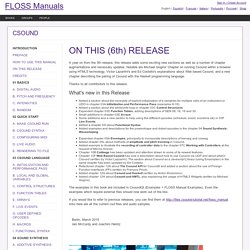
Notable are Michael Gogins' Chapter on running Csound within a browser using HTML5 technology, Victor Lazarrini's and Ed Costello's explanations about Web based Csound, and a new chapter describing the pairing of Csound with the Haskell programming language. Thanks to all contributors to this release. What's new in this Release Added a section about the necessity of explicit initialization of k-variables for multiple calls of an instrument or UDO in chapter 03A Initialization and Performance Pass (examples 8-10).Added a section about the while/until loop in chapter 03C Control Structures.Expanded chapter 03D Function Tables, adding descriptions of GEN 08, 16, 19 and 30.Small additions in chapter 03E Arrays.Some additions and a new section to help using the different opcodes (schedule, event, scoreline etc) in 03F Live Events.
Csound api. Csd and insts. Blue - a music composition environment for Csound. Csound journal. Csounders sites. Csound. Csound. Absynth Tutorials. Tips n triks. Nbviewer.ipython. Csound github. Csound floss manual. Csound is one of the best known and longest established programs in the field of audio-programming.
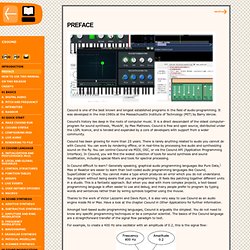
It was developed in the mid-1980s at the Massachusetts Institute of Technology (MIT) by Barry Vercoe. How Csound 6 Works. Csound-Python. From OLPC Csound can be controlled through its host API. On the XO, it is possible to write programs to use the API in C or C++, but the best way to go about it is to use the Python language. Csound offers a good level of control through its API and Python, allowing a host application to run and interface with Csound. Importing the module.